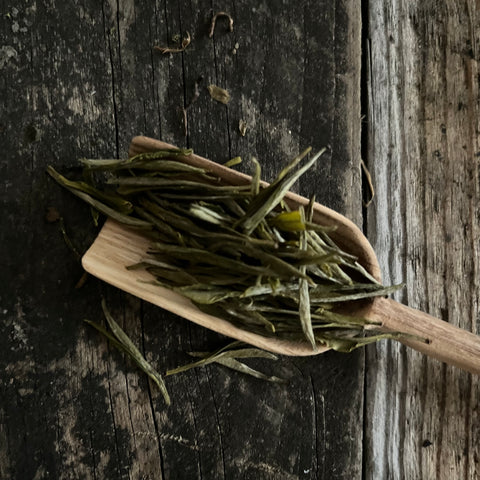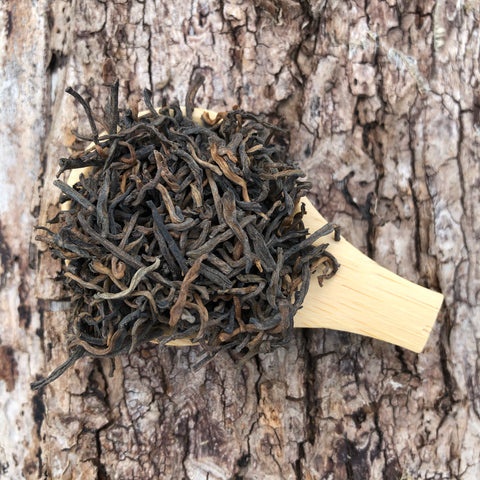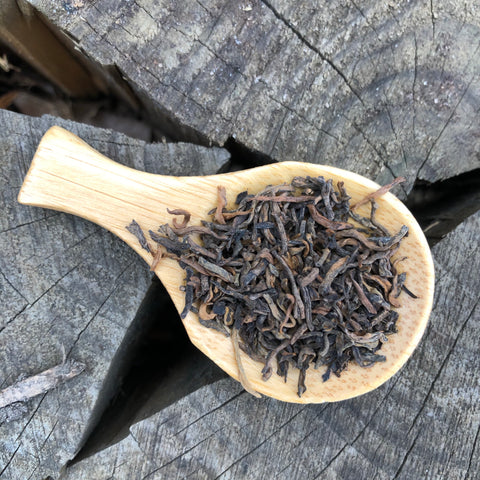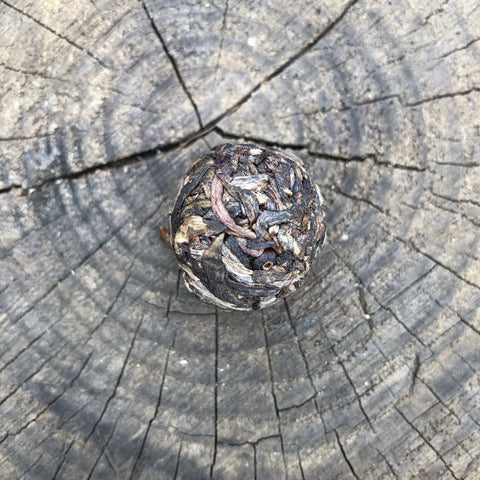2015 Shu Puer 8g Ball [pressed 2017] : A Bai La co-operative Jingmai mountain
Simply put...
From the A Bai La co-operative on Jingmai mountain this 2015 Shu Puer [pressed 2017] delivers a beautifully rich and earthy cup.
In more depth..
Tea Name : 2014 Shu Puer
Tea Maker : Mr NanKang
Origin : A Bai La Co-operative, MangJing Village, Mount Jingmai, Puer County, Yunnan Province, China
Size : 180 families
Harvest Time : April
Cultivar : Ancient Tree, medium sized leaves
Read more about the cooperative & the tea produced here on our blog :
>> https://bit.ly/2rjxAJf
>> https://bit.ly/2PtkBMN
Experience : A rich, smooth cup which brings centre & balance
Last visited by Comins : June 2019, Michelle Comins
How to prepare tea [Gaiwan]...
Amount of tea per bowl (200 ml): 2.5 g (1 tsp)
Water temperature: 100℃ / 212℉
Infusion / brewing time: 1st infusion 30 seconds then 15 seconds thereafter
Number of infusions: 8
How to enjoy: No sugar, no milk
Tales of the Tea Trade : A Bai La Co-Operative
Puer for preservation
Michelle first visited Mr NanKang & the A Bai La Cooperative in 2016 and below you can read an extract from that first visit. Below this extract you can also access two of our most recent blogs from travels back to see Mr Nankang in 2019 - when you have read these I hope you will feel inspired, like us, to drink and enjoy this most special of tea and see the balance and harmony it can bring. Simply magic.
Extract from tales of the tea trade : 'Flying into Kunming, the capital of Yunnan province, it took a gruelling 9 hours to reach Jinghong in the far south. This is a region well known for its rich and diverse styles of tea, and it was the puer tea, a unique style that originated in the region, and the black teas, in particular Dian Hong, that I had come to see [...]
Yunnan province is a land very different from the modern cultivation and terraced tea elds you see in other parts of the world. Here, ancient tea trees, some hundreds of years old, are cultivated in natural forests rich with biodiversity...The experience was to be a magical one, and it was Mr Nankang who inspired us to write the book [...] In about 180 AD, the Blang ethnic minority group migrated through the area and discovered tea. Limited available land meant that they started to cultivate tea trees in the forest [..] The area is now the largest and best-preserved cultivated ancient tree plantation in the world [..] the prime conditions here only exist because of the understanding gained by the farmers through studying nature over time[...]

The tea here is high quality and highly valued, requiring no pesticides or fertilizers However, Mr Nankang explained how the local people, with limited processing and marketing skills, lose out in the value chain[....]many locals have now formed a cooperative in Mangjing with Mr Nankang as their executive [...] By working together to process and market their own teas they can realize more of the profits and gain support on matters such as forest protection and tea forest conservation, which they work on with the support of scientists [...] As we tasted our way through their teas, it felt as though we were being invited, through the tea cup, to join a wonderful club, a club more connected with the earth and the environment than anywhere else I have ever visited [....] end of extract from tales of the tea trade :

The two most recent blogs from Michelle's return trip to Mr Nankang and the magnificent Jingmai mountain can be found here >> Blog 1 : Into the Ancient Tea Forest and Blog 2 : Mr Nan and the ancient tea trees of the Bulang



![2015 Shu Puer 8g Ball [pressed 2017] : A Bai La co-operative Jingmai mountain](http://cominstea.com/cdn/shop/products/image_0c42dcb6-7b8c-4ba8-90eb-95591c84a8b0_1024x1024.jpg?v=1620235390)
![2015 Shu Puer 8g Ball [pressed 2017] : A Bai La co-operative Jingmai mountain](http://cominstea.com/cdn/shop/products/image_0c42dcb6-7b8c-4ba8-90eb-95591c84a8b0_grande.jpg?v=1620235390)
![2015 Shu Puer 8g Ball [pressed 2017] : A Bai La co-operative Jingmai mountain](http://cominstea.com/cdn/shop/products/image_810b91af-5d5d-4af1-8315-d589cfed1574_grande.jpg?v=1620235390)
![2015 Shu Puer 8g Ball [pressed 2017] : A Bai La co-operative Jingmai mountain](http://cominstea.com/cdn/shop/products/Tea_Time_2_e5664dcc-119f-4278-8094-a333691737e2_grande.jpg?v=1620235390)
![2015 Shu Puer 8g Ball [pressed 2017] : A Bai La co-operative Jingmai mountain](http://cominstea.com/cdn/shop/products/IMG_4405_grande.jpg?v=1620235390)
![2015 Shu Puer 8g Ball [pressed 2017] : A Bai La co-operative Jingmai mountain](http://cominstea.com/cdn/shop/products/IMG_4404_grande.jpg?v=1620235390)
![2015 Shu Puer 8g Ball [pressed 2017] : A Bai La co-operative Jingmai mountain](http://cominstea.com/cdn/shop/products/Landscape_64701c3b-1af1-43c1-bb7c-5f9336fef22b_grande.jpg?v=1620235390)
![2015 Shu Puer 8g Ball [pressed 2017] : A Bai La co-operative Jingmai mountain](http://cominstea.com/cdn/shop/products/IMG_4408_grande.jpg?v=1620235390)
![2015 Shu Puer 8g Ball [pressed 2017] : A Bai La co-operative Jingmai mountain](http://cominstea.com/cdn/shop/products/IMG_4407_grande.jpg?v=1620235390)
![2015 Shu Puer 8g Ball [pressed 2017] : A Bai La co-operative Jingmai mountain](http://cominstea.com/cdn/shop/products/IMG_4410_c71bf941-ae0a-4c6d-9823-397e22e61b94_grande.jpg?v=1620235390)



